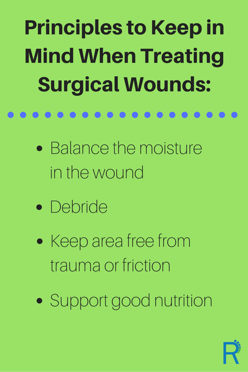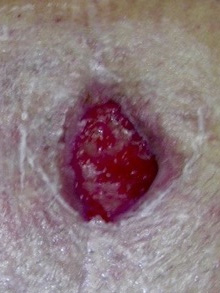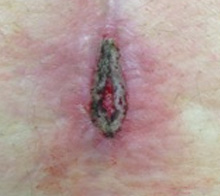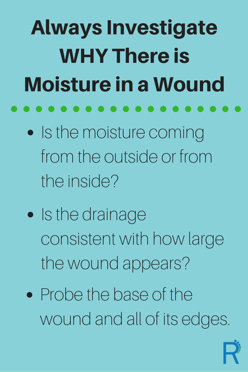Surgical Wounds That Are Left Open (On Purpose)

Last month we explored one type of surgical wound: What happens when a closed surgical incision opens up?
This month, let’s look at the other type of surgical wound:
Surgical Wounds That Are Left Open (On Purpose)
WHY are they left open?
Surgical wounds are left open for a number of reasons:
- Presence or risk of infection in the wound (to close an infected wound can result in worsening the infection)
- Not enough tissue can be approximated to close the wound without risk of opening
- The patient or wound site is not healthy enough for a surgical wound closure procedure

If all goes well, surgical wounds are GOOD looking wounds: they have a “beefy” red wound base that usually has a moderate amount ofsero-sanguinous
drainage. There will be exudate from all the exposed tissue.
The buttock wound below began as an abscess and then was surgically opened, cleaned out and left to heal without closure.
Here’s what we see in this wound:
- The wound bed has a very moist and healthy appearance.
- The middle of the wound is deeper than the edges.
- The edges on this wound show good attachment with a thin line of new epithelial tissue (new skin) all the way around.All signs point to this wound healing well.

The goals of wound healing with these open surgical wounds are like any other wound, which is to assist the wound to go through the stages of healing:
- Inflammation (when first surgically addressed)
- Proliferation (filling in of new granulation tissue)
- Remodeling (maturing of the scar tissue)
Principles explained:
Balance the moisture in the wound: use dressings that add moisture if a wound is dry or wick away moisture if a wound has heavy exudate. Negative Pressure Wound Therapy (NPWT) can be very helpful with surgical wounds to improve healing rates and manage wound exudate. NPWT is a closed dressing system that uses consistent negative pressure to absorb exudate, assist in angiogenesis, granulation tissue formation, and wound contraction. It is very helpful in deeper or larger wounds to fill them in or to prepare them for eventual surgical closure.
Remove any dead tissue in the wound: Debride the wound as necessary to remove devitalized tissue. Debris in the wound can attract bacteria (which can lead to infection and/or be an impediment to new tissue covering that area)
Keep area free from trauma or friction: Surgical wounds (like the buttock wound above) may be in places subject to physical trauma that will stop new growth of tissue. If there is any friction or direct pressure, devise a dressing, adjust positioning, or add pressure relief as much as possible. Be creative! If one section or edge is not healing as well as another, investigate to see if there is interference from some mechanical force. Be a detective!
Support good nutrition: Many times people who undergo surgery may already be depleted nutritionally or dehydrated. Address behaviors that will improve protein and nutrient intake and keep the patient hydrated.

When a wound is large and has a lot of depth, sometimes the edges can become “rolled” or “invaginated”. This is also called “epiboly”. Basically, the epithelial cells are trying to migrate from the edge across the wound and reach DOWN toward the wound before the base of the wound is even with the edge. The edges then sometimes appear “tucked in” and stop migrating any further, and stall the wound from healing.
In the photo, the edges on the right side of the abdominal wound are rolled in.
To address this, the edges can be irritated with a silver nitrate stick to effectively “open it back up” and allow the wound bed to continue to fill in and attach to the edges. Rolled edges on larger wounds happen especially when a wet to dry dressing has been used for an extended period of time: the edges dry out and the wound bed remains moist. The more advanced products are better at allowing the entire wound to remain a healthy moisture balance toward efficient healing.
Below is a different wound that has been treated with silver nitrate. It leaves a silver/gray film on the edge after it is applied. Sometimes this has to be applied several times in the course of healing to allow the wound to fully close.
One other difficulty with surgical wounds can be “hypergranulation” tissue (also called “hyperplasia” or, my favorite, “proud flesh”). This condition occurs when the beefy granulating tissue grows above the level of the wound bed due to too much moisture, like in the photo below.
Important: Hypergranulation can also signal that there is a sinus tract or tunnel that is not easily visualized from the opening of a wound.

When probed, the wound tunneled in all directions several centimeters and large amounts of thick drainage came out. It had to be surgically opened and several tracts had to be cleaned out. It has gone on to heal very nicely once it was opened.
Overall, surgical wounds can be very quick in healing. Keep the principles of good wound management in mind and address the speed bumps of invagination and hyperplasia right away if encountered. Keep asking the important questions to get to the BOTTOM of all your wound issues efficiently so they’ll heal fully at the TOP.
Do you have more questions about surgical incisions? Ask us by emailing them to info@eo2.com
This blog post was written by Robin Carlson, PT CWS
What is PT CWS? Physical Therapist and Certified Wound Specialist





